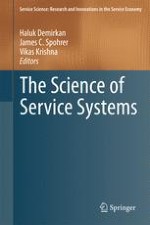2011 | OriginalPaper | Chapter
Embedding the New Discipline of Service Science
Authors : Irene Ng, Roger Maull, Laura Smith
Published in: The Science of Service Systems
Publisher: Springer US
Activate our intelligent search to find suitable subject content or patents.
Select sections of text to find matching patents with Artificial Intelligence. powered by
Select sections of text to find additional relevant content using AI-assisted search. powered by
